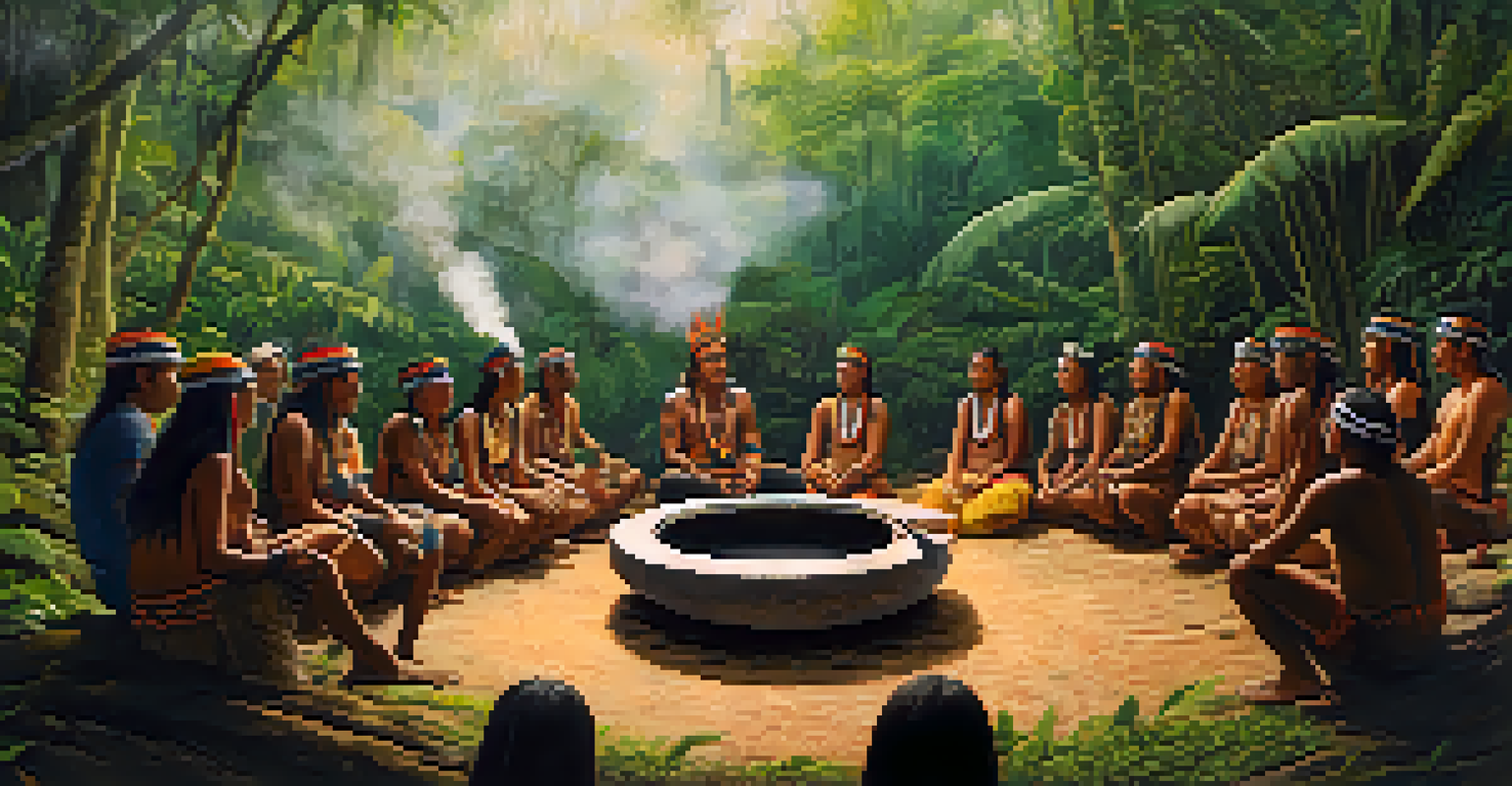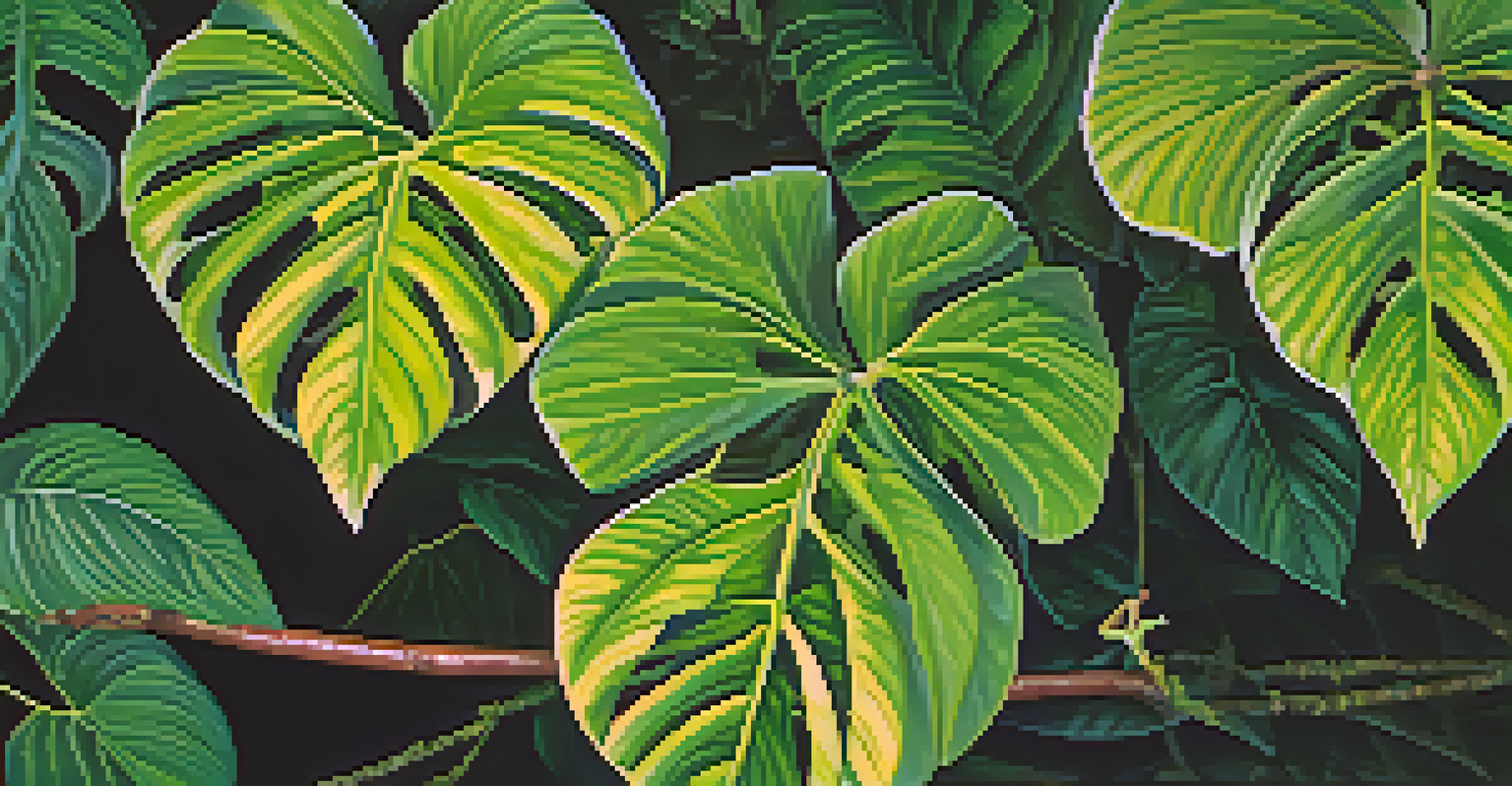Ayahuasca: A Sacred Plant with Environmental Responsibilities

Understanding Ayahuasca: Origins and Cultural Significance
Ayahuasca, a traditional brew from the Amazon, is made from the Banisteriopsis caapi vine and the Psychotria viridis leaf. This potent concoction has been used for centuries by indigenous tribes for spiritual healing and connection to the divine. Its cultural significance goes beyond mere consumption; it's a rite of passage, a tool for self-discovery, and a bridge to ancestral knowledge.
The greatest threat to our planet is the belief that someone else will save it.
The brew is often consumed in ceremonial settings, led by a shaman who guides participants through their journeys. These ceremonies are not just about the experience of the brew itself; they are deeply rooted in community, tradition, and respect for the natural world. This connection highlights the importance of cultural preservation amidst modern influences.
As interest in Ayahuasca grows globally, it's essential to honor its origins and the indigenous practices surrounding it. By understanding its cultural roots, we can appreciate the profound wisdom embedded in its use and the responsibilities that come with it.
The Ecological Importance of Ayahuasca Plants
The plants used in Ayahuasca are not just ingredients; they play a crucial role in their ecosystems. Banisteriopsis caapi and Psychotria viridis thrive in the Amazon rainforest, contributing to biodiversity and supporting countless species. Their survival is intertwined with the health of the rainforest itself, which is often referred to as the 'lungs of the Earth.'

Unfortunately, deforestation and climate change threaten these vital plants and their habitats. As the demand for Ayahuasca increases, unsustainable harvesting practices can further endanger their populations. This raises the critical question of how we can balance spiritual practices with environmental stewardship.
Cultural Roots of Ayahuasca
Ayahuasca serves as a vital spiritual tool for indigenous tribes, emphasizing the importance of understanding and respecting its cultural significance.
Protecting these plants means protecting the rainforest. Efforts to cultivate Ayahuasca sustainably not only preserve its availability but also support conservation initiatives that benefit the entire ecosystem. Sustainable practices help ensure that future generations can experience the spiritual and ecological gifts of Ayahuasca.
Sustainable Harvesting Practices for Ayahuasca
Sustainable harvesting practices are essential to ensure the longevity of Ayahuasca plants. This means gathering only what is necessary and allowing plants to regenerate naturally. By doing so, we respect both the plants and the ecosystems they inhabit, promoting a cycle of growth and renewal.
In every walk with nature, one receives far more than he seeks.
Many indigenous communities have long understood the importance of this approach, often integrating it into their spiritual philosophies. They view themselves as guardians of the forest, recognizing that their well-being is linked to the health of their environment. This wisdom can guide modern practices as well.
In recent years, there has been a push for more sustainable cultivation methods, including agroforestry and permaculture. These techniques not only help preserve Ayahuasca plants but also enhance biodiversity and soil health. By adopting these practices, we can enjoy Ayahuasca while ensuring its environmental integrity.
Ayahuasca Tourism: Balancing Spirituality and Sustainability
The rise of Ayahuasca tourism has brought both opportunities and challenges. Tourists flock to the Amazon seeking transformative experiences, but this influx can place pressure on local communities and ecosystems. Balancing the spiritual aspects of Ayahuasca with responsible tourism is essential for preserving its sacred nature.
Many retreats emphasize ethical practices, such as partnering with local shamans and supporting community initiatives. This not only enriches the experience for visitors but also helps sustain the cultural and ecological fabric of the region. When done right, tourism can become a powerful force for good.
Sustainability in Ayahuasca Practices
Sustainable harvesting and cultivation of Ayahuasca plants are essential to protect biodiversity and ensure the longevity of this sacred brew.
However, it's vital for travelers to choose retreats that prioritize sustainability and respect for indigenous practices. Educating oneself about the local culture and environment can lead to more meaningful interactions and a deeper appreciation for the sacredness of Ayahuasca.
Cultural Appropriation vs. Cultural Appreciation
As Ayahuasca gains popularity outside its indigenous roots, the line between cultural appropriation and appreciation becomes blurred. It's important to recognize that this sacred plant is deeply intertwined with the spiritual and cultural identities of indigenous peoples. Engaging with Ayahuasca should be done with respect and understanding.
Cultural appropriation involves taking elements from a culture without understanding or honoring their significance. This can lead to the commodification of sacred practices and harm indigenous communities. On the other hand, cultural appreciation acknowledges the origins and context of these practices, fostering respect and collaboration.
Engaging with Ayahuasca in a way that honors its roots means actively seeking to learn from indigenous communities. This includes supporting their rights, sharing profits from tourism, and advocating for their protection and sovereignty. By doing so, we can create a more equitable relationship with this sacred plant.
The Role of Education in Ayahuasca Practices
Education plays a pivotal role in fostering a responsible approach to Ayahuasca use. For those interested in exploring this path, understanding the cultural, ecological, and spiritual dimensions is crucial. Knowledge empowers individuals to engage with Ayahuasca respectfully and ethically.
Workshops, documentaries, and literature can provide insights into the traditional practices and beliefs surrounding Ayahuasca. Engaging with reputable sources and indigenous voices ensures a more authentic understanding. This awareness can also highlight the ecological responsibilities tied to Ayahuasca consumption.
Navigating Ayahuasca Tourism
Responsible Ayahuasca tourism can enrich local communities while preserving the spiritual and ecological integrity of the Amazon.
By prioritizing education, we can cultivate a community of informed seekers who respect the traditions and ecosystems associated with Ayahuasca. This collective mindfulness can lead to more sustainable and meaningful practices that honor both the plant and the people who have cherished it for generations.
Future Perspectives: Ayahuasca and Environmental Advocacy
As awareness of the environmental impacts of Ayahuasca grows, so too does the potential for advocacy. The stories and experiences drawn from Ayahuasca journeys can inspire individuals to take action for the environment. This connection between spirituality and ecological responsibility can lead to powerful movements.
Many individuals who experience Ayahuasca report profound insights that often translate into a desire to protect the planet. By harnessing these transformative experiences, we can create a generation of advocates committed to sustainability. This includes supporting reforestation projects and conservation efforts in the Amazon.

Ultimately, the future of Ayahuasca lies in our ability to honor its sacredness while actively participating in environmental stewardship. By fostering a sense of responsibility and connection, we can ensure that this powerful plant continues to thrive alongside the ecosystems that support it.